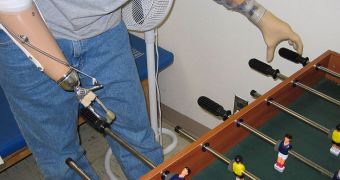Surgeons and doctors are now capable of rerouting amputees' sense of touch, from a missing limb to other areas of the body. The procedure, which is tremendously complex to perform, might lead to the development of advanced prosthetic devices that operate seamlessly.
The complex operation is called “targeted reinnervation” and it implies the relocation of nerve endings from a missing limb to an area of the arm or leg that is located above the place of amputation.
These nerve endings are then distributed in such a manner that an amputee feels as if different areas of his missing arm(s) are touched when pressure is applied to the reinnervated areas.
According to scientists, this procedure develops a tremendously strong sense of ownership of prosthetic devices, as people wearing them are capable of interacting with the mechanical appendages a lot better.
It is the hope of scientists that such investigations will allow them to create prosthetic devices that are capable of operating seamlessly on the human body, providing what is called an integrative experience for their users, Science News reports.
In a nutshell, this means that the wearer feels the prosthetic as if it were the real thing. The new type of procedure “tells us about the brain – that the brain can take this abnormal sensation and attribute it to the hand, to the arm,” explains Steven Hsiao.
“These people are feeling something. They feel like they’re really touching something, presumably,” adds the Johns Hopkins University (JHU) neuroscientist, who was not a part of the new research.
In the experiments carried out as part of the investigation, researchers in Chicago created a novel pressure-sensing system that goes on prosthetic devices. This system uses sensors to detect when something touches various portions of the artificial limb.
At the other end of the prosthetic is an array of needle-like rods, that is controlled via a computer software. Whenever a sensor detects touch, patterns of rods are activated, and they poke the reinnervated areas corresponding to the area of the artificial arm being touched.
In other words, if someone touches the elbow of a synthetic hand, then the rods would activate rerouted nerves that used to play a role in carrying data from pressure receptors in the missing elbow.
“People feel like these are tools attached to their body. Even though they are very sophisticated, they are tools,” explains Vanderbilt University bioengineer Michael Goldfarb.
“So the idea of trying to get sensory information back in would help integrate this limb as part of the body, help [people] control it and, one would argue, help them feel more whole,” he concludes.

 14 DAY TRIAL //
14 DAY TRIAL //